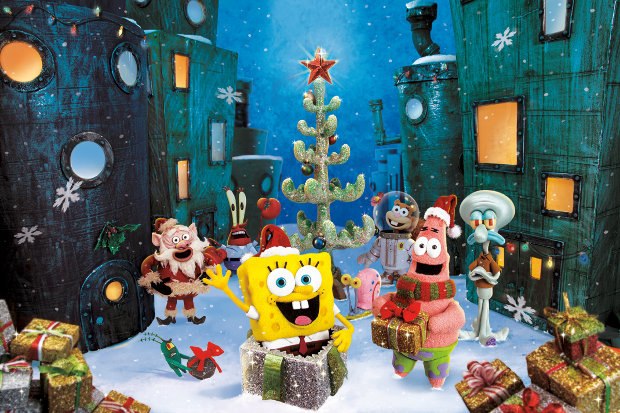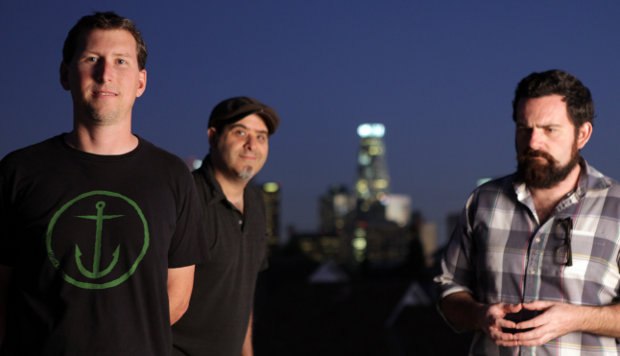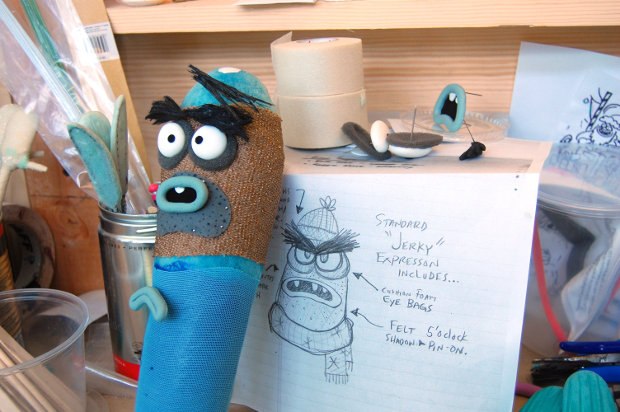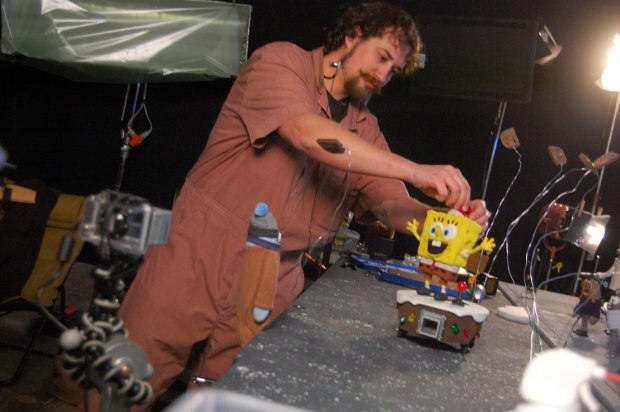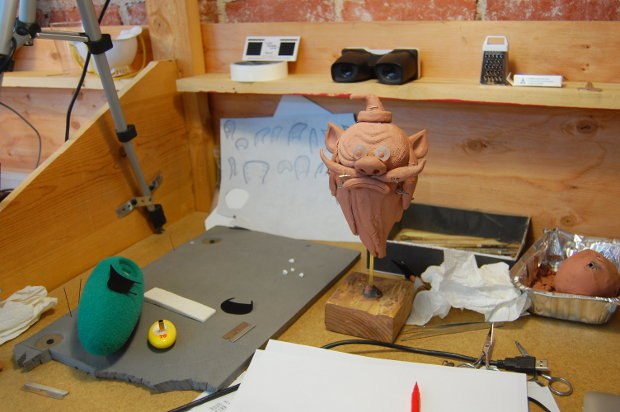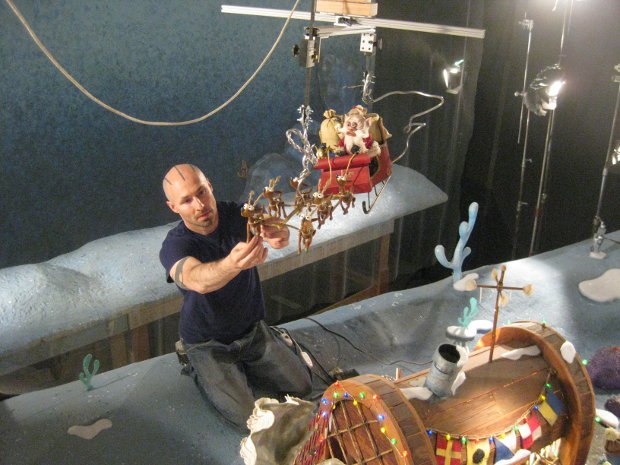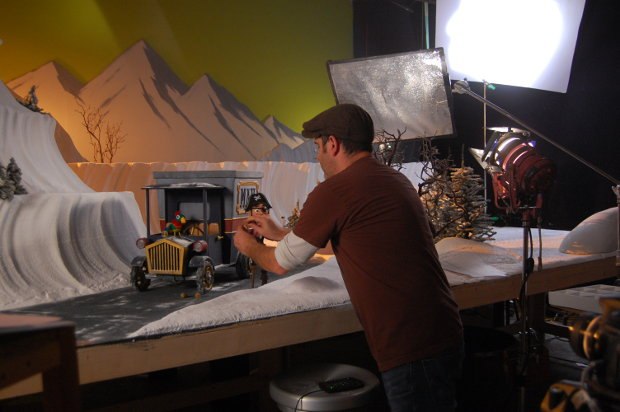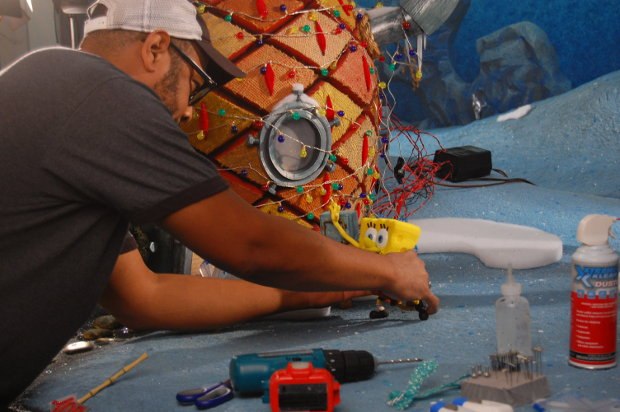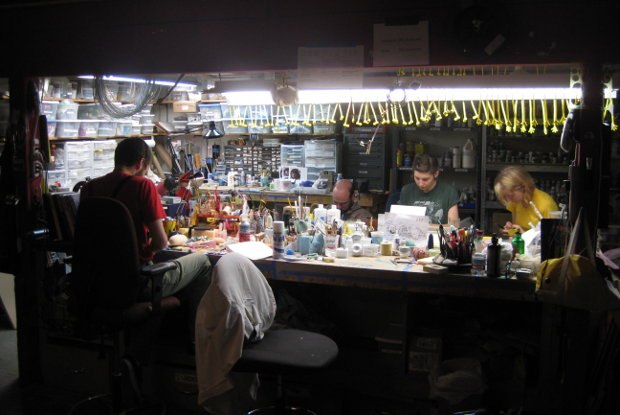Co-directors Seamus Walsh and Mark Caballero discuss the making of the Rankin/Bass styled stop-motion TV special, It’s a SpongeBob Christmas!
Regardless of your position on SpongeBob SquarePants’ legacy within the pantheon of television animation, you can’t begrudge the fact that since it first aired in 1999 the show’s popularity and unprecedented longevity are nothing short of amazing. As the first Nicktoon with over 200 episodes, SpongeBob, based on a yellow sea sponge with a tremendously annoying laugh who lives in a pineapple under the sea, is a force to be reckoned with.
Consequently, it’s nice to see the franchise step outside their comfort zone a bit and recreate Bikini Bottom and all its merry and sometimes creepy denizens in a stop-motion Christmas extravaganza. In homage to stop-motion series pioneers Arthur Rankin, Jr. and Jules Bass, whose holiday specials such as Rudolph the Red-Nosed Reindeer and Santa Claus is Comin’ to Town remain broadcast fixtures even today, Nickelodeon and series creator Steve Hillenburg have teamed with the production studio Screen Novelties to bring us a clever, funny and expertly crafted animated holiday special.
Since work began in October 2011, 60 pounds of baking soda (for snow), 42 pounds of glitter, 22 pounds of wood chips (Sandy’s tree house floor), 20 boxes of breakfast cereal (Bikini Bottom coral) and a whole mess of Jerktonium-laced fruitcake later, the special will be airing on Nickelodeon this coming Thursday, December 6th at 8 pm.
Screen Novelties, led by Mark Caballero, Seamus Walsh and Chris Finnegan, had worked with the SpongeBob group over the years on various smaller projects, including revamping the SpongeBob title sequence. They had also done some stop-motion creature work, including creation of the Abominable Snow Mollusk for the Frozen Face Off episode. Within the SpongeBob creative team, there was always talk of doing a more involved project together, which eventually turned out to be the SpongeBob Christmas special.
I recently had a chance to talk with Mark and Seamus about their handiwork and the many challenges faced bringing a 2D computer animated undersea world into a three dimensional hand animated puppet world while trying to stay true to a traditional style of stop-motion animation made famous over 40 years ago.
Dan Sarto: Tell us how this project came about? How did you get involved?
Seamus Walsh: The springboard of the idea was the song that Tom Kenny had done a few years ago [2009], “Don’t Be a Jerk, It’s Christmas.” The song proved to be quite popular, so they [the SpongeBob creators] came up with the idea of a story arc where Plankton wanted to turn everyone in Bikini Bottom into a jerk, so that by contrast, he’d appear to be nice and finally get off Santa’s naughty list so he could finally get his Christmas wish of the Krabby Patty formula.
Mark Caballero: They sent us an outline and we put in our two cents creatively. We liked where they were going with it. So after Marc [Ceccarelli] and Luke [Brookshier] boarded it, and it was cut into an animatic, we dissected the scenes to find where would be the good points to play up the goofiness of SpongeBob. But like a lot of the good Christmas specials done by Rankin and Bass, there had to be a part of the story that had heart to it as well. It’s a good story point to have, not to be a jerk for Christmas.
SW: It was also important that it not get too super sweet. We definitely wanted to keep an element of strangeness, even darker, almost scary aspects of the story as well. If you think about all the great Christmas stories, going back to Dickens’s A Christmas Carol, full of ghosts and skeletal hands, of the Ghost of Christmas Future, we didn’t try to edit out any of that more menacing stuff. We went with this tired, grumpy, very strange looking Santa.
DS: He almost has a demonic look to his face.
MC: They gave us all the freedom we wanted on Santa. They actually gave us freedom on the whole project, but on Santa in particular, we expressed our interest. There is one board, not sure if Marc or Luke drew it, where they had him looking pretty tired. We thought that was a great idea. So we came up with our own little backstory where Bikini Bottom is the last stop for Santa. He’s tired, he wants to get home, take his shoes off. You could see it in his face, “Let’s get this over with.” We thought, “Well, you know, he probably would be tired after that whole trip around the world.” We honed in on the old descriptions of Santa being a jolly old elf. We pictured him as humanoid, but not necessarily directly human.
SW: We wanted to put food stains on his beard, ketchup and stuff, but we got shot down on that one.
DS: Before we talk about some production details, let’s talk about a couple story points. Tell me about the scene where the taste buds on SpongeBob’s tongue react so happily to his eating a piece of fruitcake. It was quite funny.
SW: We were trying to find a way to do the scene without building a zillion taste bud puppets. It just needed to represent how joyously SpongeBob’s mouth was receiving this new taste sensation. It had both practical and creative considerations in the sense that we had a practical, large scale tongue we had to rig with a bunch of flappy mounds of string on the bottom. It was basically a puppeteer shot.
MC: We also filled a 55 gallon container with Cocoa Puffs mixed in with puff balls and poured that sucker onto the rig. They were supposed to represent the wave of fruitcake washing over the tongue. Seamus and his wife Robin Walsh, who takes care of all our puppet fabrication needs, they were puppeteering underneath and I poured the Cocoa Puffs. Seamus was basically covered in Cocoa Puffs powder by the time we were done.
DS: I’m always curious regarding whose sensibility rules the day regarding potentially controversial or eyebrow-raising points of a story. Did you get any pushback on Patchy kidnapping the mailman or SpongeBob being called an idiot?
MC: Patchy kidnapping the mailman and SpongeBob being called an idiot were in the original script. We didn’t think much of it that people might get upset. Once we start working on a project, we can’t let ourselves get bogged down with things like that. If you do, you start worrying and then you start editing yourself from doing what you want to do. Nickelodeon was cool with it. It’s all good fun. Unless there is anything really egregious, Nickelodeon trusts the SpongeBob gang to deliver what they do. They’ve been doing it for so many years.
DS: Tell me a bit about the details of the production. How long, how many people, how many sets?
SW: From the time we started talking to everyone about the project until the time post was finished was about a year. That includes two-three months puppet building, three months of storyboarding, with a four-five month shoot. Then there was a month or two of post.
MC: We started out with a small crew of about 8 people. We wanted to do some R&D on the characters to make sure we found the right materials and build prototype puppets. Then we expanded to as many as 30 people at one point. All together, we had around 40 people work on it.
SW: We built around 12 sets total but only five got tons of screen time, like Plankton’s lab interior and the exterior of Squidward’s and SpongeBob’s houses. We tried to use as many found and re-appropriated materials as possible rather than just sculpting real cartoony versions of the sets. We used cartoony proportions but used real world objects as much as possible. We used a lot of recognizable materials but in different contexts and different scale.
MC: We had six main animators altogether, maybe 10. We had people always rotating through. They would run over to one stage to keep animating while we setup a shot on another stage.
DS: What type of capture system were you using?
SW: We were using Dragonframe to capture frames directly to the computer hard drive. We were using Canon 5D and 7D cameras. We tried to do most things in camera. In the rare case where we couldn’t, we were using After Effects to erase rods and things like that. We did very little actual compositing. We tried to keep it close to the way a Rankin/Bass special would have been done, which is to say, doing the animation traditionally, not relying on green screening or digital set extensions. We tried to keep it small and hand made as much as possible.
MC: As the shots were finished, we would quickly take low-res QuickTimes from Dragon and drop them into a Final Cut timeline that we had setup. Once we had it to a point where Seamus and I were satisfied with the final edit, the EDL was sent over to Nickelodeon, where we would refine and clean it up into what we were finally happy with.
DS: What were the biggest challenges on this project? Were there any big surprises on the production?
SW: Well, a truck caught on fire and we had to evacuate the studio.
DS: That’s sounds like fun.
SW: A truck parked next to our building burst into flames and filled the whole studio with smoke. That was definitely a surprise. It was also a surprise how many tours we had to do. People from Nickelodeon would come over a lot to check out how things were going along. It seemed like a couple times a week we were doing tours through the studio, showing some of the executives out from New York around the sets. That was quite cool. It’s not often you get a chance to see something of this scale happening during a production.
MC: Actually, we were really surprised that Nickelodeon trusted us. But, definitely, the biggest challenge was the schedule, because we had to get it done so fast. We’re talking about a TV budget and schedule. We wished we had more time to go in and finagle some things here and there. Seamus and I would have preferred to do more of the animation ourselves, because that’s so fun to do. That said, we’re really happy with everything.
SW: It’s also a big challenge to create a pleasing puppet sometimes, especially a character like Patrick, who is this gigantic blob. When you translate that into three dimensions, you’re trying to think how not to have him come out looking like a stuffed bag full of mush. You’re trying to give him some definition and form. In 2D, it’s easier to play around with that on a shot by shot basis. With SpongeBob, he’s just this yellow brick with a face on it. We tried to go through and add little contours to him, not to make him look more realistic, but to make a pleasing 3D puppet out of a character that really only works in 2D. That was probably the most difficult thing for us to do. We had to factor in time to make sure each character was built the way it should be built and really felt like it was that character. We also had to devote considerable time to making sure Bikini Bottom had that nautical sense about it where it had a lot of castaway feelings that all fit in with the characters.
--
Dan Sarto is Editor-in-Chief and Publisher of Animation World Network.
Dan Sarto is Publisher and Editor-in-Chief of Animation World Network.
